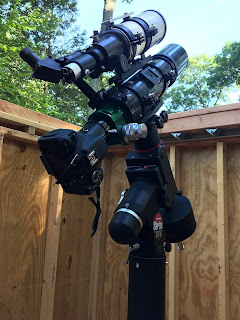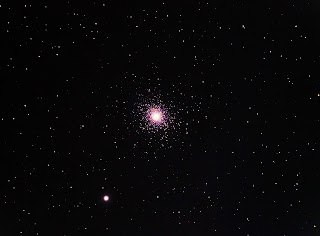I thought about building a permanent telescope pier since February of this year (2016) as I was wasting a lot of time constantly setting up and taking down my equipment. Unfortunately, my yard has a lots of trees, however, there is a small clearing in the front and Polaris is visible from two locations. I talked my wife into putting the pier in the front near our walkway. In March we noticed that one of the big trees on the side of the driveway had big holes from woodpeckers and a second tree was rotten at the bottom. The arborist recommended removing both trees. With the trees gone, I could move the pier to the side of our property and rather than just a pier, there was room for an observatory.
This portion just deals with constructing the concrete pier and mount adapter. I chose concrete pier over the a steel pier because I did not see any advantage for the greater cost. The mount adapter was made from a modified
Orion SkyView Extension with the gracious help of
Michael Stock, the industrial arts instructor at Seymour High School.
PART 1 - THE PIER
STEP 1 - Choose a Location (4/6)
The area I chose is not the ideal, however, it is the best I have in my yard. I have a decent view to the North (and Polaris) and to the South where it opens up somewhat. Also my neighbors shed shown in the second pick blocks his outside lights.
Figure 1 - looking south
Figure 2 - looking north
STEP 2 - Dig the Hole (4/29)
Figure 3 - 12" by 38" hole dug, bottom is flared to 16"
Here in southern Connecticut they recommend digging to 42 inches to get below the frost line. I did not get to 42 inches, too many large rocks and roots, but I came close at 38 inches. I had to cut through very large roots with an electric hacksaw as well removed many large rocks. The hole was about 12 inches in diameter. I flared it to a bell shape near the bottom to about 16 inches so it will serve as base (a.k.a. the footing).
STEP 3 - Build Form Tube Support Frame (4/29)
Figure 4 - Form tube support constructed (the base for the SkyShed is being constructed)
Forms usually come in 4 foot sections, however, longer ones can be found at masonry stores. I ended up getting a 10 in diameter 12 foot piece and cut it down to my desired 6 feet. It is possible to combine two smaller forms to make a longer form. This is where planning comes into play, you should have a predetermined height for the pier prior to starting the project. Since I was building an observatory (
SkyShed plans), the height had to be high enough for the telescope to see over the wall. In my case, the bottom of the mounting plate had to be between 29 and 32 inches above the base. That is why I partially constructed the floor of the
SkyShed before putting the pier in.
I attached three 2 x 4's to the form using 5/16 inch galvanized anchor bolts so the form sat 6 to 12 inches above the bottom of the hole and the top was 30 inches above the floor. I put a mark 1 inch below the top of the form for the concrete top.
STEP 4 - Prepare Mount Adapter and Rebar prior to Mixing the Concrete (4/29)
I had two 1-foot pieces of rebar on hand to lay horizontally for the footing and three pieces of 4-foot rebar wired together to be placed in the form tube. In addition, I prepared the mounting adapter so it could be set into the newly poured concrete. Also, the orientation of the adapter should be set so the mount points to the North Star. To do this, I set a survey stake and aligned it to Polaris the night before we poured the concrete.
Figure 5 - pier adapter plate constructed
I used four 5/8" by 12" galvanized L-shaped anchor bolts purchased from the
Nutty Company as a means of mounting the adapter. I chose 4 bolts rather than the standard 3 for more stability and if I ever got a different mount. I will discuss my mount and modified adapter at the end of the post.
STEP 5 - Pour Concrete (4/29)
My son and I prepared one bag of normal setting 80-lb concrete in a plastic tub and poured half into the hole, then set the two pieces of 1-ft rebar horizontally and poured the rest of the bag into the hole. Next, we set the form tube that was already attached to the 2 x 4's into the hole then leveled and secured it. Next we set the rebar into the tube, mixed and poured concrete until 1 inch below the top of the form tube. In all 5 1/2 bags of concrete were used.
STEP 6 - Set the Mount Head into the Wet Concrete (4/29)
This was relatively simple as I set a directional stake towards the North Star. I attached a piece of 3/4" plywood to the bottom of the adapter for more protection and the attached the four L-shaped anchor bolts. The adapter was set into the wet concrete at the proper orientation so the threads of the bolts were just above the concrete. I used a level to ensure the plate was level. Lastly, I back filled the hole and packet it down. I covered the top with two plastic garbage bags to keep in the moisture keep out the rain that was on its way.
STEP 7 - Remove the Form Tube (5/2)
I removed the plastic bags and the form tube was removed after 3 days using a knife.
Figure 6 - form tube is removed after 3 days
I left the adapter plate as the concrete needs at least a week to cure. I removed the adapter plate four days later and let the pier cure another seven days.
STEP 8 - Freshen Up The Pier (5/19)
I first patched the holes and smoothed off the top of the pier with ready made Quickcrete concrete patch. After two days of drying I put a coat of ultra pure white paint over the pier. I applied the paint not only for looks but also to seal the pier.
Figure 7 - pier is done with the improvements
PART 2 - THE MOUNT ADAPTER
Using the Orion SkyView Pro Telescope Mount Extension as an adapter
In order to use the pier, an adapter for the mount has to be used. There are adapters available from
Dan's Pier Plates, however, I originally needed to remove the mount after each use and it appears that adapters such as Dan's aren't meant for on and off use. I chose to make an adapter that will hold the polar alignment if the mount is removed out of a SkyView Extension (it is also 1/3 the price).
Figure 8 - The Extension with the completed bottom plate
I brought the telescope mount extension tube to
Michael Stock, the industrial arts instructor at Seymour High School for modifications. He had a student shave off the bottom plate to make it flush so it could be attached to a 0.5 inch thick aluminum plate that I purchased on Amazon. The aluminum plate had to be cut to an 8 inch round shape.
Figure 9 - The top and bottom of the extension along with the aluminum plate
Mike and his student attached the bottom extension to the aluminum plate with one 3/8 inch bolt and four 1/4 inch bolts.
Figure 10 - The bottom of the extension along attached to the aluminum plate
With everything all attached, the setup looks like this:
Figure 11 - The complete setup
I waited before posting this because I wanted to make sure it all worked. I am happy to report the whole system works really well. The polar alignment was not perfect when I took it off and reattached it days later however, it was very close. There was a big savings in time with the setup even though I had to polar align it. The pictures of the setup were taken when the shed was being constructed. As of this post it is still in progress.
The following are images I took with the pier:
M53
Mars
M64 (Black Eye Galaxy)
M5 and Saturn
Mars with NGC5897
The Ring Nebula, M57, Revisited!



































